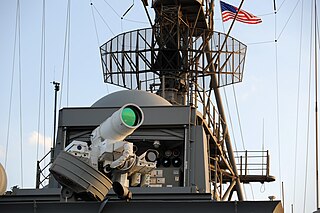History
| | This section is empty. You can help by adding to it. (April 2018) |
Zenith Star was a Directed-energy weapon that started development as part of the US Strategic Defense Initiative. [1]
It included the Alpha laser, a high energy hydrogen fluoride chemical laser, and the LAMP mirror which was a 7 segment adaptive optics mirror. [2]
Zenith Star was never put in orbit, but the Alpha LAMP Integration (ALI) project carried out some ground-based tests. [3] : 20
| | This section is empty. You can help by adding to it. (April 2018) |
Around 1998 Space-Based lasers were reconsidered and led to the Space Based Laser - Integrated Flight eXperiment (SBL-IFX) project 2000-2002. [4] [5]

The Strategic Defense Initiative (SDI), derisively nicknamed the "Star Wars program", was a proposed missile defense system intended to protect the United States from attack by ballistic strategic nuclear weapons. The concept was announced on March 23, 1983, by President Ronald Reagan, a vocal critic of the doctrine of mutually assured destruction (MAD), which he described as a "suicide pact". Reagan called upon American scientists and engineers to develop a system that would render nuclear weapons obsolete.

The Boeing YAL-1 Airborne Laser Testbed weapons system was a megawatt-class chemical oxygen iodine laser (COIL) mounted inside a modified military Boeing 747-400F. It was primarily designed as a missile defense system to destroy tactical ballistic missiles (TBMs) while in boost phase. The aircraft was designated YAL-1A in 2004 by the U.S. Department of Defense.
Anti-satellite weapons (ASAT) are space weapons designed to incapacitate or destroy satellites for strategic or tactical purposes. Although no ASAT system has yet been utilised in warfare, a few countries have successfully shot down their own satellites to demonstrate their ASAT capabilities in a show of force. ASATs have also been used to remove decommissioned satellites.

The National Ignition Facility (NIF) is a laser-based inertial confinement fusion (ICF) research device, located at Lawrence Livermore National Laboratory in Livermore, California, United States. NIF's mission is to achieve fusion ignition with high energy gain. It achieved the first instance of scientific breakeven controlled fusion in an experiment on December 5, 2022, with an energy gain factor of 1.5. It supports nuclear weapon maintenance and design by studying the behavior of matter under the conditions found within nuclear explosions.

A directed-energy weapon (DEW) is a ranged weapon that damages its target with highly focused energy without a solid projectile, including lasers, microwaves, particle beams, and sound beams. Potential applications of this technology include weapons that target personnel, missiles, vehicles, and optical devices. In the United States, the Pentagon, DARPA, the Air Force Research Laboratory, United States Army Armament Research Development and Engineering Center, and the Naval Research Laboratory are researching directed-energy weapons to counter ballistic missiles, hypersonic cruise missiles, and hypersonic glide vehicles. These systems of missile defense are expected to come online no sooner than the mid to late-2020s.

MIRACL, or Mid-Infrared Advanced Chemical Laser, is a directed energy weapon developed by the US Navy. It is a deuterium fluoride laser, a type of chemical laser.

The Air Force Research Laboratory (AFRL) is a scientific research organization operated by the United States Air Force Materiel Command dedicated to leading the discovery, development, and integration of aerospace warfighting technologies, planning and executing the Air Force science and technology program, and providing warfighting capabilities to United States air, space, and cyberspace forces. It controls the entire Air Force science and technology research budget which was $2.4 billion in 2006.
Space warfare is hypothetical combat in which one or more belligerents are situated in outer space. The scope of space warfare therefore includes ground-to-space warfare, such as attacking satellites from the Earth; space-to-space warfare, such as satellites attacking satellites; and space-to-ground warfare, such as satellites attacking Earth-based targets. Space warfare in fiction is thus sub-genre and theme of science fiction, where it is portrayed with a range of realism and plausibility.

The Missile Defense Agency (MDA) is the section of the United States government's Department of Defense responsible for developing a layered defense against ballistic missiles. It had its origins in the Strategic Defense Initiative (SDI) which was established in 1983 by Ronald Reagan and which was headed by Lt. General James Alan Abrahamson. Under the Strategic Defense Initiative's Innovative Sciences and Technology Office headed by physicist and engineer Dr. James Ionson, the investment was predominantly made in basic research at national laboratories, universities, and in industry. These programs have continued to be key sources of funding for top research scientists in the fields of high-energy physics, advanced materials, supercomputing/computation, and many other critical science and engineering disciplines—funding which indirectly supports other research work by top scientists, and which was most politically viable to fund within the Military budget of the United States environment. It was renamed the Ballistic Missile Defense Organization in 1993, and then renamed the Missile Defense Agency in 2002. The current director is U.S. Navy Vice Admiral Jon A. Hill.

Brilliant Pebbles was a ballistic missile defense (BMD) system proposed by Lowell Wood and Edward Teller of the Lawrence Livermore National Laboratory (LLNL) in 1987, near the end of the Cold War. The system would consist of thousands of small satellites, each with missiles similar to conventional heat seeking missiles, placed in low Earth orbit constellations so that hundreds would be above the Soviet Union at all times. If the Soviets launched its ICBM fleet, the pebbles would detect their rocket motors using infrared seekers and collide with them. Because the pebble strikes the ICBM before the latter could release its warheads, each pebble could destroy several warheads with one shot.
The High Energy Liquid Laser Area Defense System (HELLADS), is a counter-RAM system under development that will use a powerful (150 kW) laser to shoot down rockets, missiles, artillery and mortar shells. The initial system will be demonstrated from a static ground-based installation, but in order to eventually be integrated on an aircraft, the final design would require a maximum weight of 750 kg (1,650 lb) and a maximum envelope of 2 cubic meters (70.6 feet3).

A solid-state laser is a laser that uses a gain medium that is a solid, rather than a liquid as in dye lasers or a gas as in gas lasers. Semiconductor-based lasers are also in the solid state, but are generally considered as a separate class from solid-state lasers, called laser diodes.

The HLONS (HMMWV Laser Ordnance Neutralization System), commonly known as ZEUS, is a solid-state laser weapon which is used by the U.S. military in order to neutralize surface land mines and unexploded ordnance. The ZEUS-HLONS system was a co-operative effort between Sparta Inc and NAVEODTECHDIV (Naval Explosive Ordnance Disposal Technology Division) to demonstrate that a moderate-power commercial solid state laser (SSL) and beam control system could be integrated onto a Humvee (HMMWV) and used to clear surface mines, improvised explosive devices (IEDs), or unexploded ordnance from supply routes and minefields.

Project Excalibur was a Lawrence Livermore National Laboratory (LLNL) Cold War–era research program to develop an X-ray laser system as a ballistic missile defense (BMD) for the United States. The concept involved packing large numbers of expendable X-ray lasers around a nuclear device, which would orbit in space. During an attack, the device would be detonated, with the X-rays released focused by each laser to destroy multiple incoming target missiles. Because the system would be deployed above the Earth's atmosphere, the X-rays could reach missiles thousands of kilometers away, providing protection over a wide area.

A laser weapon is a type of directed-energy weapon that uses lasers to inflict damage. Despite decades of research and development, as of January 2020, directed-energy weapons, including lasers, remain at the experimental stage. Whether they will be deployed as practical, high-performance military weapons remains to be seen. One of the major issues with laser weapons is atmospheric thermal blooming, which is still largely unsolved. This issue is exacerbated when there is fog, smoke, dust, rain, snow, smog, foam, or purposely dispersed obscurant chemicals present. In essence, a laser generates a beam of light that requires clear air or a vacuum to operate.
North Oscura Peak, is a summit in the Oscura Mountains in Socorro County, New Mexico is the location of an Air Force Research Laboratory (AFRL) site in the northern portion of the White Sands Missile Range. It rises to an elevation of 7,976 feet.

The Bold Orion missile, also known as Weapons System 199B (WS-199B), was a prototype air-launched ballistic missile (ALBM) developed by Martin Aircraft during the 1950s. Developed in both one- and two-stage designs, the missile was moderately successful in testing, and helped pave the way for development of the GAM-87 Skybolt ALBM. In addition, the Bold Orion was used in early anti-satellite weapons testing, performing the first interception of a satellite by a missile.

The AN/SEQ-3 Laser Weapon System or XN-1 LaWS is a laser weapon developed by the United States Navy. The weapon was installed on USS Ponce for field testing in 2014. In December 2014, the United States Navy reported that the LaWS system worked perfectly against low-end asymmetric threats, and that the commander of Ponce was authorized to use the system as a defensive weapon.
The DF-ZF is a Chinese hypersonic glide vehicle (HGV), previously denoted by the Pentagon as WU-14 and currently officially operational on October 1st, 2019, in the 70th anniversary of the People's Republic of China. The DF-ZF is designed to be mounted on a DF-17, a type of ballistic missile specifically designed to carry HGVs.
In air and missile defense (AMD), the Integrated Air-and-Missile Defense system (IAMD) is an SMDC research program to augment the aging surface-to-air missile defense systems and to provide the United States Army with a low-cost, but effective complement to kinetic energy solutions to take out air threats. Brigade level higher energy lasers are used in truck mounted systems called HELMTT. At lower levels, the Army needs to develop interceptors that don't cost more than small, unmanned aircraft systems. In early research they have successfully used 5-kilowatt lasers on a Stryker combat vehicle. The Mobile Expeditionary High-Energy Laser (MEHEL) was used at MFIX at Fort Sill, Oklahoma, in the first half of April, 2017.